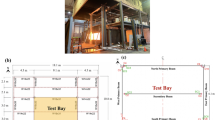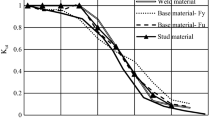Abstract
Correct assessment of the steel connection performance under fire requires including the time-dependent response of steel material in the structural analysis. Failure to do so might impose critical threats on the stability and integrity of steel structures. To this aim, the objective of this study is to investigate the effect of thermal creep on the behavior of shear endplate beam-column connections subjected to transient-state fire temperatures. First, finite element models of shear endplate assemblies are developed using ABAQUS and validated against experimental work available in the literature. Parametric studies are then carried out to study the effect of key geometrical, thermal, and material parameters on the overall response of the frame assembly in fire while explicitly including creep. This includes heating and cooling rates, initial cooling temperature, column size and height, load ratio, plate thickness, and steel grade. The results show that including thermal creep causes a reduction in the induced compressive forces and an increase in the mid-span beam deflection, for about six times higher in some cases, thus earlier development of beam catenary action. It is also concluded that lower heating and cooling rates result in larger beam tying forces on the shear end plate connections, which can reach values around ten times larger than when creep is neglected. This study shows that the current practice of neglecting creep in fire analyses, especially in slow heating, may underestimate the forces that are exerted on the shear endplate connections during fire and thus leads to unsafe structural design.














Similar content being viewed by others
References
Ramli-Sulong NH, Elghazouli AY, Izzuddin BA (2007) Behaviour and design of beam-to-column connections under fire conditions. Fire Saf J 42(6–7):437–451. https://doi.org/10.1016/j.firesaf.2006.09.003
Bailey CG, Burgess IW, Plank RJ (1996) Analyses of the effects of cooling and fire spread on steel-framed buildings. Fire Saf J 26(4):273–293. https://doi.org/10.1016/S0379-7112(96)00027-6
Luecke WE, McColskey JD, McCowan CN, Banovic SW, Fields RJ, Foecke TJ, Siewert TA, Gayle FW (2005) Federal building and fire safety investigation of the world trade center disaster: mechanical properties of structural steels
Wang YC, Dai XH, Bailey CG (2011) An experimental study of relative structural fire behaviour and robustness of different types of steel joint in restrained steel frames. J Constr Steel Res 67(7):1149–1163. https://doi.org/10.1016/j.jcsr.2011.02.008
Hu Y, Davidson B, Burgess I, Plank R (2008) Experimental study on flexible end plate connections in fire. In: Proceedings of 5th European conference on steel structures, Graz, Austria, pp 1007–1012
Hantouche EG, Sleiman SA (2016) Response of double angle and shear endplate connections at elevated temperatures. Int J Steel Struct 16(2):489–504. https://doi.org/10.1007/s13296-016-6019-8
Hantouche EG, Sleiman SA (2017) Axial restraint forces in shear endplates of steel frames due to fire. J Constr Steel Res 128:528–541. https://doi.org/10.1016/j.jcsr.2016.09.021
Torić N, Harapin A, Boko I (2013) Modelling of steel creep at high temperatures using an implicit creep model. Key Eng Mater 553:13–22. https://doi.org/10.4028/www.scientific.net/KEM.553.13
Morovat MA (2014) Creep buckling behavior of steel columns subjected to fire. Dissertation, The University of Texas at Austin
EN 1993-1-2 (2005) Eurocode 3: design of steel structures—part 1–2: general rules—structural fire design, European Committee for Standardization, Brussels
Kodur VR, Dwaikat MM (2010) Effect of high temperature creep on the fire response of restrained steel beams. Mater Struct 43(10):1327–1341. https://doi.org/10.1617/s11527-010-9583-y
Li G, Zhang C (2012) Creep effect on buckling of axially restrained steel columns in real fires. J Constr Steel Res 71:182–188. https://doi.org/10.1016/j.jcsr.2011.09.006
Morovat MA, El Ghor AH, Hantouche EG (2018) Time-dependent response of flush endplate connections to fire temperatures. J Struct Eng 144(4):04018023. https://doi.org/10.1061/(ASCE)ST.1943-541X.0002006
Yang K, Yu Z (2013) Experimental research on the creep buckling of fire-resistant steel columns at elevated temperature. Steel Compos Struct 15(2):163–173. https://doi.org/10.12989/scs.2013.15.2.163
Harmathy TZ (1967) A comprehensive creep model. J Basic Eng 89(3):496–502. https://doi.org/10.1115/1.3609648
El Ghor AH, Hantouche EG (2017) Thermal creep mechanical-based modeling for flush endplate connections in fire. J Constr Steel Res 136:11–23. https://doi.org/10.1016/j.jcsr.2017.04.022
Abaqus Ver. 6.14 Documentation (2014) Dassault Systemes Simulia Corporation
Hantouche EG, Al Khatib KK, Morovat MA (2018) Modeling creep of steel under transient temperature conditions of fire. Fire Saf J 100:67–75. https://doi.org/10.1016/j.firesaf.2018.07.006
Wang W, Yan S, Liu J (2017) Studies on temperature induced creep in high strength Q460 steel. Mater Struct 50:68. https://doi.org/10.1617/s11527-016-0941-2
Fields AB, Fields JR (1989) Elevated temperature deformation of structural steel. National Bureau of Standards NISTIR 88-3899
Lee J, Morovat MA, Hu G, Engelhardt MD, Taleff EM (2013) Experimental investigation of mechanical properties of ASTM A992 steel at elevated temperatures. Eng J 50:249–272
Hu Y, Davison BJ, Burgess WI, Plank RJ (2007) Comparative study of the behaviour of BS 4190 and BS EN ISO 4014 bolts in fire. In: Proceedings of 3rd international conference on steel and composite structures (ICSC07), pp 587–592
Garlock EM, Selamet S (2010) Modeling and behavior of steel plate connections subject to various fire scenarios. J Struct Eng 136(7):897–906. https://doi.org/10.1061/(ASCE)ST.1943-541X.0000179
Author information
Authors and Affiliations
Corresponding author
Additional information
Publisher's Note
Springer Nature remains neutral with regard to jurisdictional claims in published maps and institutional affiliations.
Rights and permissions
About this article
Cite this article
Al Haddad, H.O., Hantouche, E.G. & Al Khatib, K.K. Numerical Studies on the Creep Behavior of Shear Endplate Connection Assemblies UNDER Transient Heating. Fire Technol 55, 2341–2367 (2019). https://doi.org/10.1007/s10694-019-00869-x
Received:
Accepted:
Published:
Issue Date:
DOI: https://doi.org/10.1007/s10694-019-00869-x




